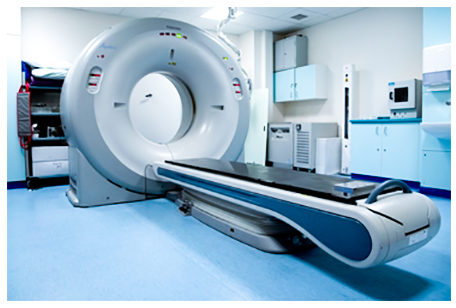
Write the full form of CT scan. In what ways is it more advantageous and conventional than x-ray? Mention any two uses of this diagnosis.
Answer
572.1k+ views
Hint: In these, the high-frequency electromagnetic radiations are used to create pictures of body organs and later it is used for diagnosis.
Complete answer:
In CT scan ‘CT’ stands for computed tomography. CT scan or CAT (computed axial tomography) scan is a diagnostic procedure that produces highly X-rayed images for the body which shows health issues. An X-ray, or X-radiation, is a penetrating form of high-energy electromagnetic radiation.
The advantages of CT scans over x-rays includes
-The CT Scanned image shows blood vessels, soft tissues, bones of the various body parts whereas in a conventional x-ray only bones can be seen.
-The CT scan can provide a larger amount of data than a conventional x-ray.
-CT scan allows the physician to manipulate the data into various views without additional imaging of the patient.
-We can get a CT scan on any part of your body, but not an x-ray.
-It can selectively enhance or remove structures from the images.
-It has a short study time (15 to 20 minutes) with high-quality images.
Uses of this diagnosis
-It detects abnormalities in the body, such as tumors, abscesses, abnormal blood vessels, etc, when they are suspected by symptoms or other tests.
-It gives the surgeon a clear picture of an area of your body before certain types of surgery.
-It pinpoints the exact site of tumors before radiotherapy.
-It helps the doctors in finding the right place to take tissue samples (biopsies).

Note: The CT scanner was designed in 1972 by the British designer Godfrey N. Hounsfield (later Sir Godfrey) and the South African (later American) physicist Alan Cormack. CT checking was at that point by and large used by 1979, the year Hounsfield and Cormack were granted the Nobel Prize in Medicine or Physiology for its advancement. X-ray or X-radiation in many languages is referred to as Röntgen radiation, after the German scientist Wilhelm Röntgen, who discovered it on November 8, 1895. He named it X-radiation which refers to an unknown type of radiation.
Complete answer:
In CT scan ‘CT’ stands for computed tomography. CT scan or CAT (computed axial tomography) scan is a diagnostic procedure that produces highly X-rayed images for the body which shows health issues. An X-ray, or X-radiation, is a penetrating form of high-energy electromagnetic radiation.
The advantages of CT scans over x-rays includes
-The CT Scanned image shows blood vessels, soft tissues, bones of the various body parts whereas in a conventional x-ray only bones can be seen.
-The CT scan can provide a larger amount of data than a conventional x-ray.
-CT scan allows the physician to manipulate the data into various views without additional imaging of the patient.
-We can get a CT scan on any part of your body, but not an x-ray.
-It can selectively enhance or remove structures from the images.
-It has a short study time (15 to 20 minutes) with high-quality images.
Uses of this diagnosis
-It detects abnormalities in the body, such as tumors, abscesses, abnormal blood vessels, etc, when they are suspected by symptoms or other tests.
-It gives the surgeon a clear picture of an area of your body before certain types of surgery.
-It pinpoints the exact site of tumors before radiotherapy.
-It helps the doctors in finding the right place to take tissue samples (biopsies).

Note: The CT scanner was designed in 1972 by the British designer Godfrey N. Hounsfield (later Sir Godfrey) and the South African (later American) physicist Alan Cormack. CT checking was at that point by and large used by 1979, the year Hounsfield and Cormack were granted the Nobel Prize in Medicine or Physiology for its advancement. X-ray or X-radiation in many languages is referred to as Röntgen radiation, after the German scientist Wilhelm Röntgen, who discovered it on November 8, 1895. He named it X-radiation which refers to an unknown type of radiation.
Recently Updated Pages
Master Class 12 Business Studies: Engaging Questions & Answers for Success

Master Class 12 Economics: Engaging Questions & Answers for Success

Master Class 12 English: Engaging Questions & Answers for Success

Master Class 12 Maths: Engaging Questions & Answers for Success

Master Class 12 Social Science: Engaging Questions & Answers for Success

Master Class 12 Chemistry: Engaging Questions & Answers for Success

Trending doubts
What are the major means of transport Explain each class 12 social science CBSE

Which are the Top 10 Largest Countries of the World?

Draw a labelled sketch of the human eye class 12 physics CBSE

How much time does it take to bleed after eating p class 12 biology CBSE

Explain sex determination in humans with line diag class 12 biology CBSE

Differentiate between homogeneous and heterogeneous class 12 chemistry CBSE




